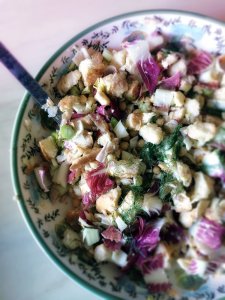
Peasant bread salad
I have found that some of my best and most inspired dishes come from when the cupboards are almost bare.
It should be the opposite, right? When there is not much to work with, one would expect a tasteless, lifeless plate of food; sad and used only for fueling the body without the hope of ever being truly enjoyed.
However, I have found that it is that exact moment to use my kitchen magic. I lovingly gather all the little bits and scraps together from here and there, and when I scrape the jars of condiments and bring together items which served alone, would amount to nothing, and create pairings I probably would not have thought of with a full fridge, that I literally create something from nothing. I guess that is why my old blog was called The Leftover Queen!If life lessons have taught me anything these past few years, it is that there is always something when it seems there is nothing, like magic often, things just come together. We usually have to dig deep for these things, but when they finally surface they grant a new lease on life and give us the hope needed to go on.
Living in Italy and especially being in Sardinia where there is a lot of unemployment for much of the year, I have been inspired by how people still manage to live a fulfilling life by scraping things together. It is often a tapestry of patchwork whether it is building a home over years instead of months, utilizing resources when they become available, foraging for food or firewood or like this dish, creating a feast for the family when there is little money to spend on acquiring it.Cucina Povera, or “the poor kitchen” is the backbone of Italian cuisine, no matter what region you are talking about. It relies on fresh, local and seasonal food that is ready to hand and therefore, less expensive, often free. Anything abundant, or growing wildly and affordable becomes the backbone of a dish and, of course, anything left over never goes to waste. The spirit of la Cucina Povera is about embracing limitations and making do creatively with what you have. All food should be honored and that means not allowing it become waste rather we breathe new life into it and allow it to shine.Those of you who follow me on Instagram might have noticed several hashtags I have been using on a lot of my food posts like: #modernpeasant #modernpeasantcooking and #modernpeasantlifestyle
These hashtags indicate recipes or ideas that are all in the spirit of living a full life, even if you have fewer resources than you want or even sometimes less than you really need. One of my mentors, someone whose ideas I trust told me “but Jenn, nobody wants to be a peasant”, and it made me think long and hard about using the word “peasant” to describe my lifestyle and my attempt to bring this concept to others who might need it. How could I help others with these ideas, if people were repelled by the word? I am grateful for that conversation because it helped me dig deeper and ultimately decide to continue to use the word.
Words have power and evoke certain feelings. When I call myself a peasant, a word that harkens back to earlier times, I tap into the ways of my ancestors, a long line of resourceful folks who used old-fashioned skills to prosper. When I tap into their knowledge, I feel less depressed about my current standing in the world, I actually feel empowered.
Sometimes circumstances force us to dig into the ways of the past to stretch thin resources. Appreciating struggle and the lessons it can teach us about tenacity, and grit and resilience, all words that empower me, too, is a gift not easily acquired. Some of the hard lessons I have learned in this journey are skills that I will always treasure and use no matter how well off I may be in the future.
And one of those skills is how to use my kitchen magic to make a great meal out of stuff most people would throw right into the bin.Bread salad has a recorded history back to the 16th century when Italian poet, Bronzino sang the praises of onions with oil and vinegar served with toast, which is believed to be the first reference to Panzanella, the well-known Italian bread salad. I knew of Panzanella, of course, but did not have tomatoes or onions (the vegetable that was paired with the bread until tomatoes came to Italy) to make that particular dish. I relied instead on the principles for how Panzanella was originally created…out of necessity and with whatever was to hand.
This colorful bread salad is just that, a mix of stale bread, mostly empty jars of tuna and beans, veggies wilting in the fridge, and foraged wild fennel and lemons all flavored with a tangy dressing made from pantry staples: olive oil, red wine vinegar, salt, and pepper. To go from stressing about what to make for lunch, to tucking into a nice dish of this salad was transformative not only for my mood but also for my eager belly.
The idea is not necessarily to follow this exact recipe (but if you wish to, please do!), but to use it as a road guide to creating your own delicious meals with what is available. So rethink that jar of mayo in the fridge with not but a smear left in it, or that sad bit of wilting celery or get outside and see what wild edibles can be foraged in your own backyard, then marry all the bits and create something wonderful and delicious. Then sit back and feel the sense of accomplishment it gives you when you taste it, the satisfaction that can be had by feeding your family a nutritious homemade meal out of nothing.
To learn more about the Modern Peasant life, check out my about page.
And my new Modern Peasant group on Facebook where I hope to foster a community that shares all kinds of ideas that appeal to the modern peasant, like foraging, cooking on an open fire, making herbal medicines, beauty treatments and natural household cleaners, gardening, etc. If these topics interest you, I hope you will join us there!
- 2-3 cups stale bread, cut into bite-sized chunks
- 1/2 cup olive oil
- 4 tablespoons red wine vinegar
- 4 tablespoons lemon juice
- water (as needed)
- salt & pepper
- 4 ounces of tuna
- 2-3 anchovy fillets, chopped
- 2/3 cup chickpeas
- 1 ½ cups of diced vegetables (I used radicchio, celery, and fennel)
- Fennel fronds to garnish
-
- Place bread into a large serving bowl.
- In a medium mixing bowl whisk together olive oil, red wine vinegar, lemon juice, salt, and pepper. Pour over the bread chunks and mix.
- Let rest while you gather the other ingredients and chop the veggies.
- Before adding the other ingredients, check the texture of the bread chunks.
- If the bread chunks are too hard (you want them to have a bit of a crunch and not be mushy) you can add a little water and then stir well again.
- Then add the other ingredients to the bowl. Stir well, season to taste and serve.








Leave a Reply